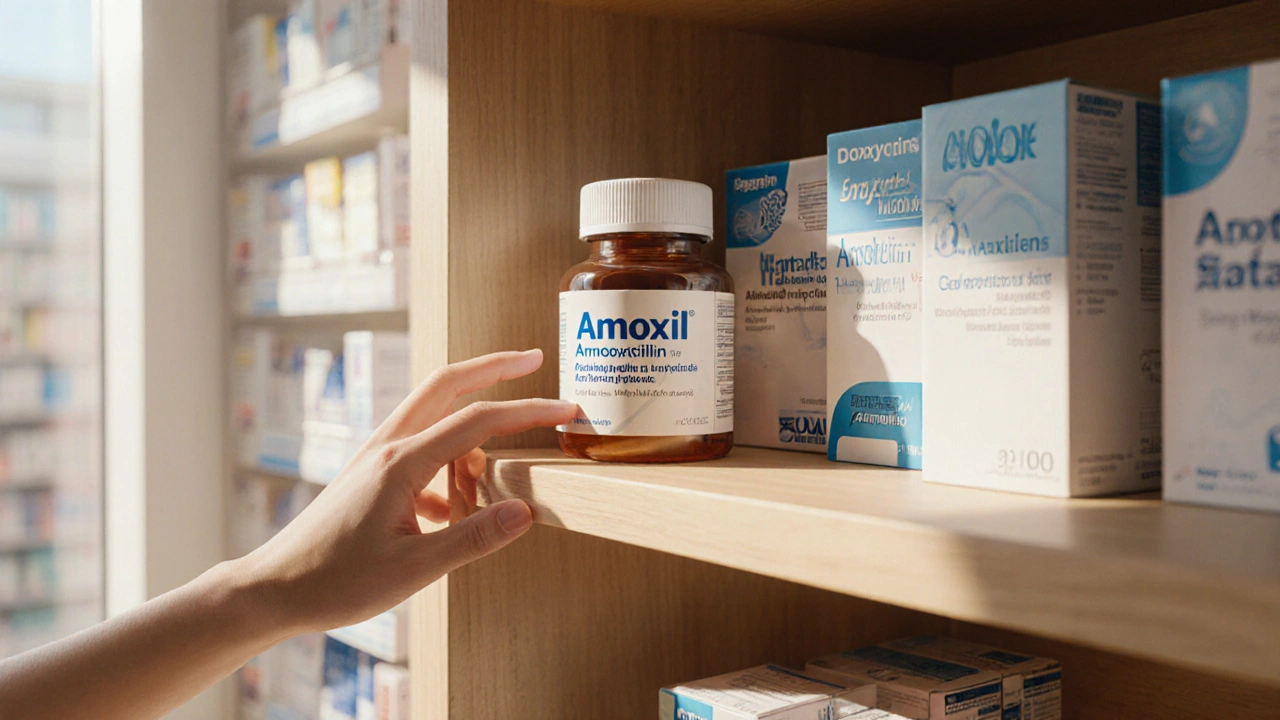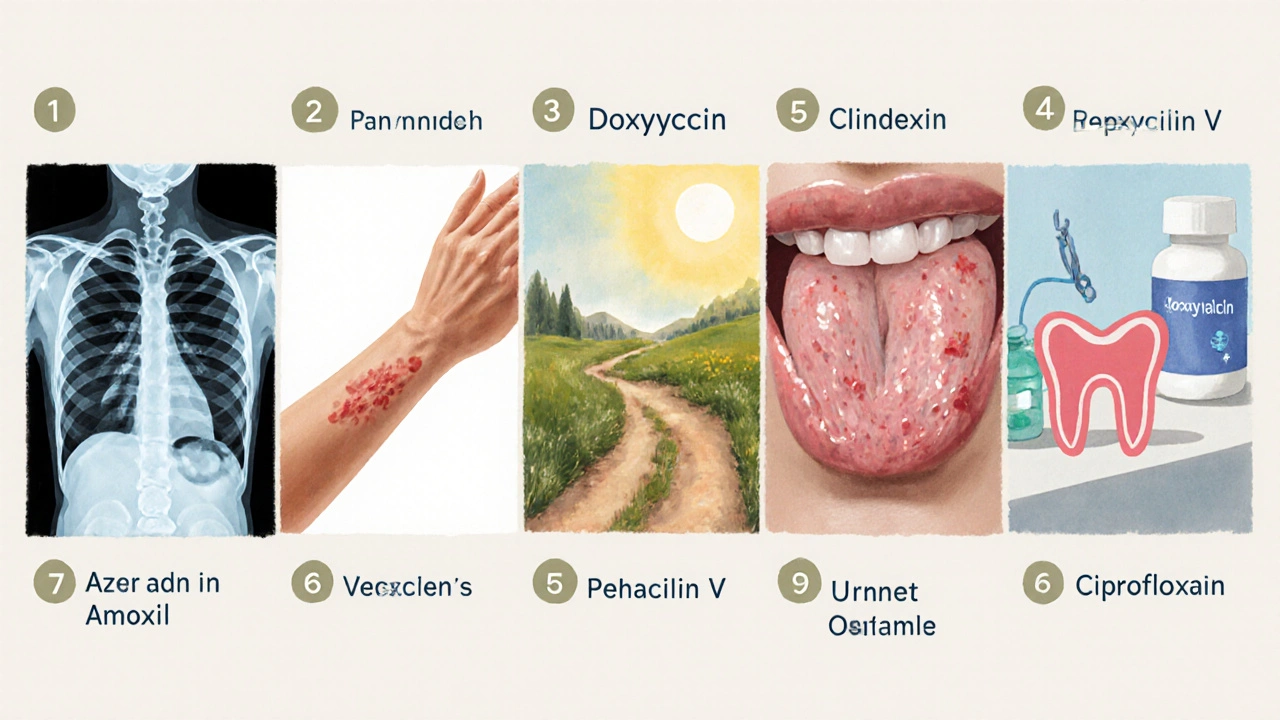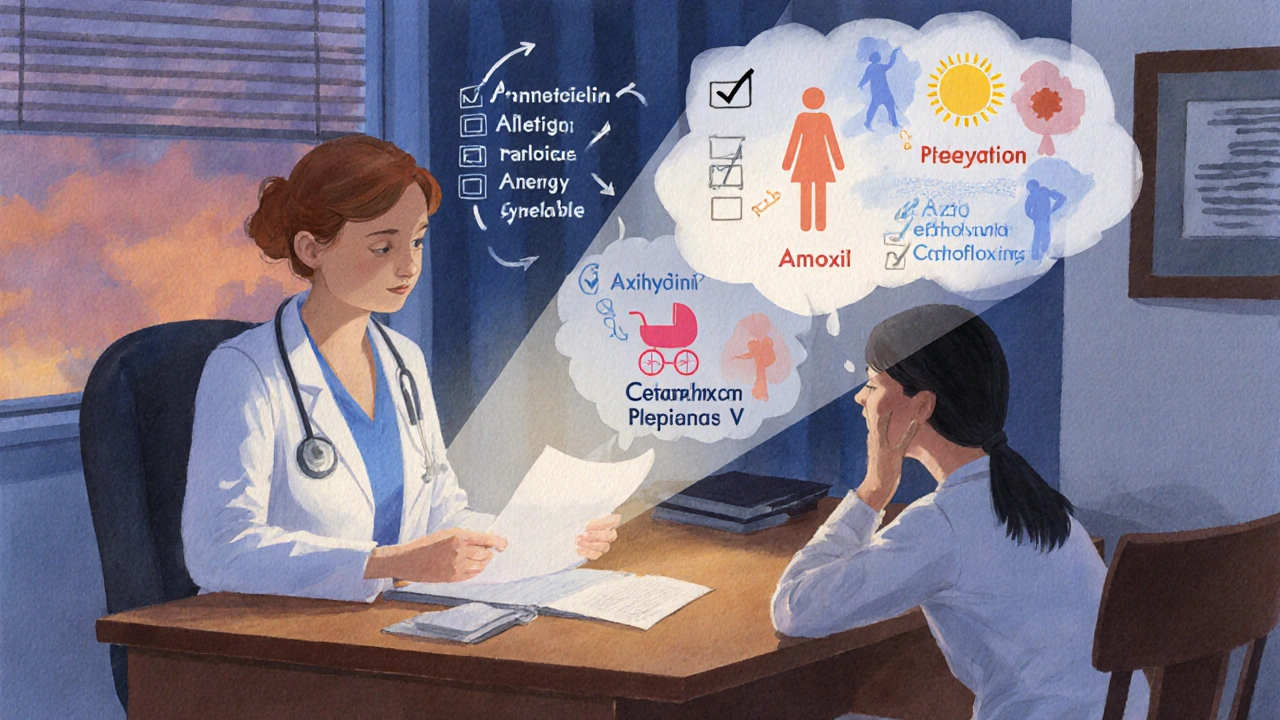Amoxicillin (Amoxil) vs. Common Alternatives: A Practical Comparison
 Oct, 2 2025
Oct, 2 2025
Amoxil vs. Alternatives: Antibiotic Decision Helper
Recommended Antibiotics for Your Condition
Side Effect Comparison Table
| Antibiotic | Typical Side Effects | Serious Risks | Dosing Frequency |
|---|
Quick Take
- Amoxil is a broad‑spectrum penicillin‑type antibiotic ideal for ear, sinus and throat infections.
- Azithromycin and doxycycline are good substitutes when patients are allergic to penicillin.
- Cephalexin offers a similar spectrum but needs more frequent dosing.
- Clindamycin shines against certain anaerobic infections but can cause C.difficile colitis.
- Choosing the right drug depends on infection type, resistance patterns and patient tolerance.
When you or a loved one needs an antibiotic, the bustling pharmacy aisle can look confusing. The name Amoxil (Amoxicillin) is a beta‑lactam antibiotic that fights a wide range of bacterial infections, especially in the respiratory tract, urinary system and skin often tops the list. But it’s not the only player. Below we compare Amoxil to the most common alternatives, breaking down how each works, when it’s best used, and what side‑effects to watch for. By the end, you’ll have a clear picture of which drug fits your situation - no medical degree required.
How Amoxil Works and When It’s Usually Prescribed
Amoxil belongs to the penicillin family, meaning it attacks bacteria by disrupting the formation of their cell walls. Without a sturdy wall, bacteria burst under their own pressure and die. This mechanism makes Amoxil especially effective against Streptococcus pneumoniae, Haemophilus influenzae and many strains of Escherichia coli.
Typical prescriptions include:
- Acute otitis media (middle‑ear infection)
- Sinusitis
- Pharyngitis (strep throat)
- Uncomplicated urinary‑tract infections
- Dental abscesses
The drug is taken orally, usually twice a day, and a full course lasts 5‑10 days depending on the infection severity.
Why You Might Need an Alternative
Even though Amoxil is a workhorse, it isn’t perfect. Two major reasons push doctors toward another antibiotic:
- Penicillin allergy: Roughly 10% of patients report a true allergy, ranging from mild rash to life‑threatening anaphylaxis.
- Resistance: In some regions, bacteria have developed enzymes (beta‑lactamases) that deactivate Amoxil.
When either factor shows up, clinicians reach for a different class of drugs. Below are the most common substitutes.
Alternative #1 - Azithromycin (a macrolide antibiotic that blocks bacterial protein synthesis
Azithromycin is a favorite for patients allergic to penicillin. Its long half‑life lets you take it once daily, often for just three days. It covers many of the same Gram‑positive organisms as Amoxil, plus atypical bacteria like Mycoplasma pneumoniae.
Common uses:
- Community‑acquired pneumonia
- Chlamydial infections
- Skin infections caused by Staphylococcus aureus (non‑MRSA)
Side‑effects are typically mild - occasional stomach upset or a brief change in taste.
Alternative #2 - Doxycycline (a tetracycline antibiotic that inhibits bacterial ribosomal activity
Doxycycline is another go‑to for penicillin‑allergic patients, especially when the infection could involve intracellular organisms. It’s taken twice a day and can treat both Gram‑positive and Gram‑negative bacteria.
Typical indications:
- Lyme disease
- Rickettsial infections (e.g., RockyMountain spotted fever)
- Acne vulgaris (long‑term low‑dose use)
Photosensitivity is a notable side‑effect - you’ll want to avoid prolonged sun exposure while on the drug.
Alternative #3 - Cephalexin (a first‑generation cephalosporin that also disrupts bacterial cell‑wall synthesis
Cephalexin’s spectrum is close to Amoxil’s but it tends to be better against certain staphylococcal strains. It’s often chosen when a patient has a mild penicillin allergy (e.g., rash) that doesn’t preclude a cephalosporin.
Key uses:
- Skin and soft‑tissue infections
- Bone infections (osteomyelitis) in combination therapy
- Urinary‑tract infections caused by susceptible E.coli
It must be taken three to four times daily, which can be a compliance hurdle.

Alternative #4 - Clindamycin (a lincosamide antibiotic that blocks protein synthesis in anaerobic bacteria
Clindamycin shines in deep‑tissue or anaerobic infections, like intra‑abdominal abscesses or serious dental infections. It’s also useful for patients with MRSA‑susceptible strains.
Typical scenarios:
- Necrotizing fasciitis (as part of combination therapy)
- Bone infections caused by anaerobes
- Complicated skin infections
The biggest warning is the risk of Clostridioides difficile colitis - a severe diarrheal condition that can be life‑threatening.
Alternative #5 - Penicillin V (an oral penicillin with a narrower spectrum than amoxicillin
When the infection is clearly caused by susceptible streptococci, Penicillin V can be a cheaper, equally effective choice. It’s taken two to three times daily and has a well‑known safety profile.
Best for:
- Strep throat
- Rheumatic fever prophylaxis
- Simple skin infections in children
Because it’s less broad, it spares many of the gut flora, reducing the chance of upset stomach.
Alternative #6 - Ciprofloxacin (a fluoroquinolone that inhibits bacterial DNA gyrase and topoisomerase IV
Ciprofloxacin is reserved for more serious Gram‑negative infections, especially when other agents fail. It’s not a first‑line for routine ear or throat infections due to its broad impact on gut bacteria and potential tendon toxicity.
Typical use cases:
- Complicated urinary‑tract infections
- Traveler’s diarrhea caused by Campylobacter
- Bone and joint infections where other agents are ineffective
Patients should avoid high‑impact exercise during therapy and stay hydrated to reduce tendon‑related side‑effects.
Side‑Effect and Safety Snapshot
All antibiotics share some common risks: allergic reactions, gastrointestinal upset, and the chance of fostering resistant bacteria. Below is a quick look at the most frequent adverse events for each drug discussed.
| Antibiotic | Typical Side‑Effects | Serious Risks | Dosing Frequency |
|---|---|---|---|
| Amoxil | Diarrhea, nausea, rash | Severe allergic reaction, C.difficile colitis (rare) | Twice daily |
| Azithromycin | Abdominal pain, mild liver enzyme rise | QT prolongation, severe allergic reaction | Once daily (3‑day course) |
| Doxycycline | Esophagitis, photosensitivity | Intracranial hypertension (rare) | Twice daily |
| Cephalexin | Diarrhea, headache | Severe allergic reaction | Three to four times daily |
| Clindamycin | Nausea, metallic taste | C.difficile colitis, severe skin reactions | Four times daily |
| Penicillin V | Mild GI upset | Allergic anaphylaxis | Two to three times daily |
| Ciprofloxacin | Headache, nausea | Tendon rupture, QT prolongation, C.difficile colitis | Twice daily |
Decision Guide: Picking the Right Antibiotic
Here’s a practical flow you can run through with your healthcare provider:
- Identify the infection type. Is it a respiratory, urinary, skin, or dental issue?
- Check bacterial susceptibility. Labs may show if the culprit produces beta‑lactamase, steering you away from Amoxil.
- Assess patient factors. Look for penicillin allergy, liver or kidney impairment, pregnancy, or need for once‑daily dosing.
- Match the infection to the drug’s spectrum. For atypical pneumonia, go with azithromycin; for anaerobic wounds, consider clindamycin.
- Weigh side‑effect profiles. If the patient loves the outdoors, avoid doxycycline’s photosensitivity.
- Finalize the regimen. Choose dose, duration, and counseling points (e.g., take Amoxil with food to reduce stomach upset).
Following this checklist helps you land on the most effective, safest option without unnecessary trial‑and‑error.
Practical Tips for All Antibiotics
- Finish the full prescribed course, even if you feel better early on.
- Take the medication at the same times each day to maintain steady blood levels.
- Stay hydrated - especially with fluoroquinolones - to protect your tendons.
- Report any rash, swelling, or breathing difficulty immediately.
- Ask your pharmacist about probiotic use to offset gut disruption.
Remember, antibiotics treat bacterial infections only. Viral illnesses like the common cold won’t get better with Amoxil or any of its alternatives.
When to See a Doctor Again
If symptoms persist beyond 48‑72hours after starting therapy, or if you develop fever, worsening pain, or new discharge, schedule a follow‑up. It may signal resistance, an incorrect diagnosis, or a need for a different drug.

Frequently Asked Questions
Can I take Amoxil and azithromycin together?
Generally no. Combining two broad‑spectrum antibiotics isn’t needed and can increase side‑effects. Your doctor may switch drugs if one isn’t working, but they won’t usually prescribe them together.
What if I’m allergic to penicillin but not to cephalosporins?
A mild penicillin allergy (rash only) often allows safe use of first‑generation cephalosporins like cephalexin. However, severe reactions (anaphylaxis) rule out cephalosporins too. Always discuss your allergy history with your prescriber.
Is amoxicillin safe during pregnancy?
Yes. Amoxil is classified as Pregnancy Category B (US) or has a favourable safety profile in most guidelines. It’s often the first choice for UTIs or bacterial sinusitis in pregnant women.
Why does doxycycline cause photosensitivity?
Tetracyclines like doxycycline bind to skin cells and, when exposed to UV light, generate reactive molecules that lead to sunburn‑like reactions. Wearing sunscreen and protective clothing mitigates this risk.
Can clindamycin replace amoxicillin for a tooth infection?
If the infection involves anaerobic bacteria or the patient can’t tolerate penicillins, clindamycin is a solid alternative. It penetrates bone and gum tissue well, but the prescriber must weigh the higher risk of C.difficile colitis.
Is a three‑day azithromycin course as effective as a ten‑day amoxil course?
For certain infections like uncomplicated community‑acquired pneumonia, studies show a short azithromycin regimen achieves similar cure rates to longer amoxil courses, thanks to its long half‑life and high tissue concentrations.
Max Rogers
October 2, 2025 AT 18:11Nice overview! The way you laid out the infection types and matched them with each antibiotic makes it super easy to pick the right one. I especially liked the quick‑take bullet points – they’re perfect for a fast read before heading to the pharmacy.
Louie Hadley
October 3, 2025 AT 10:51This guide hits the sweet spot between detail and readability. It’s clear enough for someone without a medical background, yet it still gives the nitty‑gritty on side‑effects and dosing. Props for the practical flowchart vibe.
Ginny Gladish
October 4, 2025 AT 03:31The analysis is thorough, but the presentation could benefit from clearer sub‑headings for each alternative. Also, a note on local resistance patterns would make the guide more actionable for clinicians in varied regions.
Faye Bormann
October 4, 2025 AT 20:11Alright, let’s dive deep into why this comparison matters for everyday folks and not just the textbook crowd. First off, the layout of the table is spot‑on – you can glance at typical side‑effects, serious risks, and dosing frequency without hunting through paragraphs. That said, many people still stumble on the nuance of “penicillin allergy” vs. “cephalosporin cross‑reactivity,” and this guide could expand that section with a quick decision tree.
Speaking of decision trees, the infection‑type selector feels a bit too generic; adding a “high‑risk patient” filter (think immunocompromised or elderly) would elevate the practicality. Also, while azithromycin’s once‑daily dosing is a major convenience, the QT‑prolongation risk is understated – a brief warning about concomitant meds that affect heart rhythm would be prudent.
On the doxycycline front, the photosensitivity warning is spot‑on, but many users forget to take it with plenty of water to avoid esophagitis. A reminder in the dosage instructions would help reduce that avoidable side‑effect.
Cephalexin’s three‑to‑four‑times‑daily schedule is indeed a compliance hurdle; perhaps suggesting a timed‑release formulation where available could be a useful tip.
Clindamycin shines in anaerobic infections, yet the C. difficile warning deserves a bold highlight – maybe a separate call‑out box – because the risk isn’t trivial.
Penicillin V’s narrow spectrum is great for stewardship, but you might want to mention that it’s often a first‑line for streptococcal pharyngitis in children, which could be a persuasive point for pediatric contexts.
Ciprofloxacin’s tendon‑risk disclaimer is essential, especially for active adults; a quick note to avoid high‑impact sports while on therapy is worth adding.
Overall, the guide’s tone is friendly and approachable, which is a huge plus. If you sprinkle in a few real‑world anecdotes – like a patient who switched from amoxil to azithromycin due to a rash and saw rapid improvement – it would humanize the data even more.
Finally, a short FAQ on drug‑drug interactions (think warfarin, oral contraceptives, antacids) could round out the resource, making it a one‑stop shop for anyone navigating antibiotics.
Kathy Butterfield
October 5, 2025 AT 12:51Love the clean layout! 😊 The side‑effect table is super helpful and the emojis make it feel less intimidating. 👍
Zane Nelson
October 6, 2025 AT 05:31The exposition, while comprehensive, borders on verbosity; a more succinct summary would enhance readability for the lay audience.
Sahithi Bhasyam
October 6, 2025 AT 22:11Great job,, guys!!! The content is sooo useful,,, I love how you included the dosing frequency ;;) But, maybe add a note about taking amoxil with food?? It helps reduce stomach upset!!! Also, pls consider a brief section on resistance patterns – especially in hot climates!!! Thx!!
mike putty
October 7, 2025 AT 14:51Thanks for putting this together! It’s reassuring to see clear guidance, especially for people who might be nervous about antibiotics. Keep it up.
Kayla Reeves
October 8, 2025 AT 07:31While the guide is informative, it seems to overlook the moral responsibility of prescribing antibiotics responsibly. Overuse fuels resistance, and that should be emphasized more strongly.
Abhinanda Mallick
October 9, 2025 AT 00:11Honestly, this is the kind of practical tool that should be everywhere – from clinics to community centers. But let’s not forget that in our country, many patients still rely on over‑the‑counter antibiotics, which undermines the whole stewardship effort.
Richard Wieland
October 9, 2025 AT 16:51Clear and concise – well done.
rachel mamuad
October 10, 2025 AT 09:31From a pharmacodynamics perspective, the table captures the core PK/PD parameters, but consider adding MIC breakpoints for common pathogens – that would appeal to the geek in all of us.
Amanda Anderson
October 11, 2025 AT 02:11The simple breakdown really helps me decide which med to ask my doctor for. I appreciate the clear language.
Carys Jones
October 11, 2025 AT 18:51It’s a decent guide, but I think it downplays the seriousness of C. difficile risks, especially with clindamycin. People need to be warned more starkly.
Roxanne Porter
October 12, 2025 AT 11:31Absolutely agree with the points raised above. The risk of C. difficile with clindamycin warrants a stronger warning and perhaps an alternative suggestion for patients with prior episodes.
Jonathan Mbulakey
October 13, 2025 AT 04:11The balanced approach in the guide aligns well with practical prescribing. It’s useful to see both the benefits and the caveats laid out clearly.
Warren Neufeld
October 13, 2025 AT 20:51Great summary! Having the key points in bullet form makes it easy to reference when I’m at the pharmacy.
Deborah Escobedo
October 14, 2025 AT 13:31Excellent work on the long‑form section; it really helps to see the step‑by‑step decision guide laid out in detail.
Dipankar Kumar Mitra
October 15, 2025 AT 06:11Cool guide, but remember that many people in our community self‑medicate. We need more public education on why consulting a doctor first is crucial.
Tracy Daniels
October 15, 2025 AT 22:51Nice job! 😊 Adding a quick note about probiotic use after a course of antibiotics could be a helpful addition.